You're close to the answer on question 3 ankur. I didn't mention hydrolysis. Just a minor detail you need to change in your answer.
Welcome to the Great Organic Chemistry Challenge kiddos. Let's see what you got. Give it your best shot. You should know that I don't have the answers to any of these questions. Don't bank on me. Wake out of your slumber and stop wasting time on optical isomerism. There are some places in questions where I will have to help you, but you must post queries on those portions first! Atleast I would know that you have tried yourself upto that point.
For all those indulging in optical isomerism, this speech(inspired by Sylvester Stallone from Spy Kids 3 : Game Over) :
"I'm coming back
To settle the score...
For imprisoning me
For uuusing me
So now...I'm going to take this to the next.level!!!"
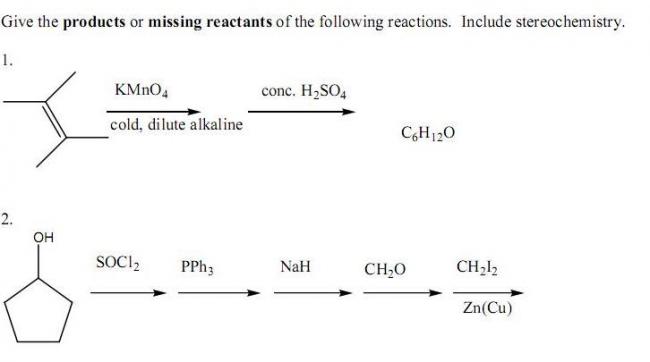
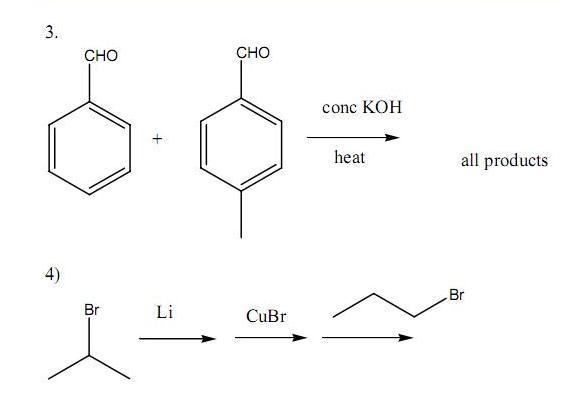
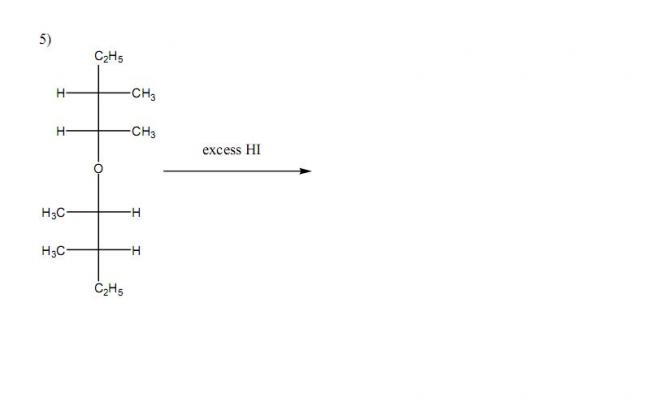
Q6. Using 1-propanol as the precursor compound, synthesise the following compounds in good yield(try using the shortest possible number of steps) -:
a) Hexan-3-one
b) 4,5-diethylocta-4-ene (high yield)
c) 4-ethylheptan-4-ol
d) hexan-1,4-diol
e) Methane
f) Crotonaldehyde
Q7. An unknown organic compound X, with molecular formula C6H10O3 is optically active(your love of optical activity has brought us to this conclusion, subho).
When X is reacted with acidic dichromate, it turns green.
When X is reacted with per-iodic acid, compound A with molecular formula C4H6O3 and B, C2H4O2 are formed.
B is found to be a carboxylic acid. A responds positively to Tollen's test and negatively to the iodoform test. Find X, A and B and identify the reactions and products.
Q8. 
A) Aqueous sulfuric acid
B) Mercuric acetate followed by reaction with Sodium borohydride
C) Diborane followed by hydrogen peroxide/NaOH
D) mCPBA followed by H2SO4
Q9. The major product obtained on reaction of CH3COCH2COOC2H5 with one equivalent NaH and one equivalent methyl iodide is?
Q10. The reaction of phenylacetylene with one equivalent of methyl magnesium bromide followed by reaction with benzaldehyde and hydrolysis yields?
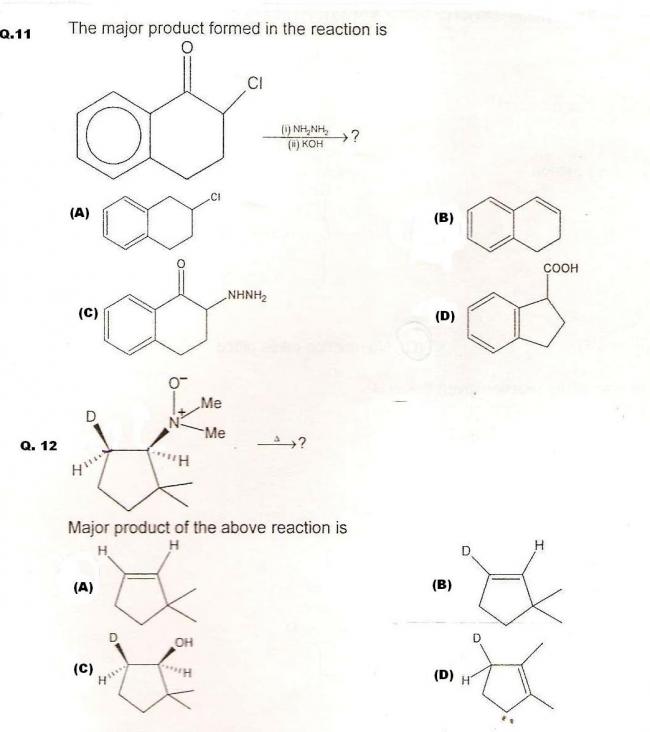
Q13. Which of the following organic compounds will not give foul odour of isocyanide on heating with chloroform and potassium hydroxide? (may be MCQ)
(A) para-methylaniline
(B) H2N - CH2 - COOH
(C) meta-aminobenzoic acid
(D) para-aminosulfonic acid
Q14. When α,Β-unsaturated cyclohexanone is reacted with (CH3)2CuLi and hydrolysed, the product obtained is?
Q15. Which compound undergoes decarboxylation on warming?
(A) Me-CO-COOH
(B) Me-CO-O-Et
(C) Me-CO-CH2COOH
(D) HO-CH2-COOH
Q16. Which of the following reacts with ammoniacal AgNO3 solution? (MCQ)
(A) 1-butyne
(B) MeCHO
(C) HCOOH
(D) PhCOPh
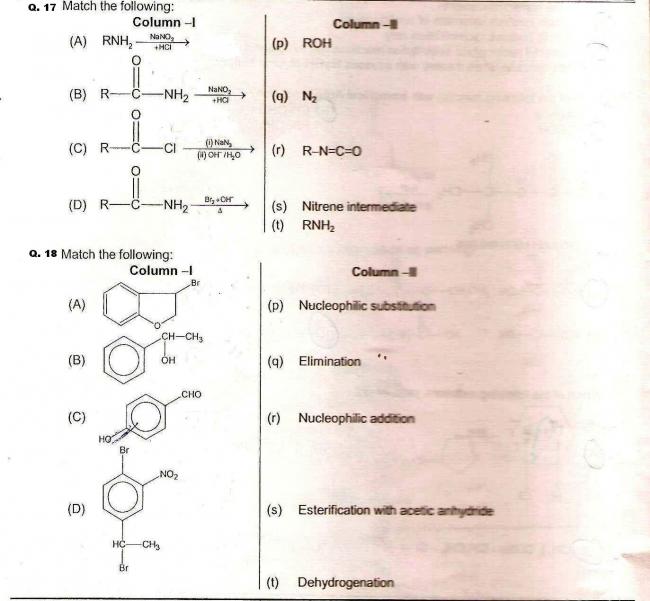
Q19. Explain why gyloxal gives the Tollen's test but not the Fehling's or Benedict's test.
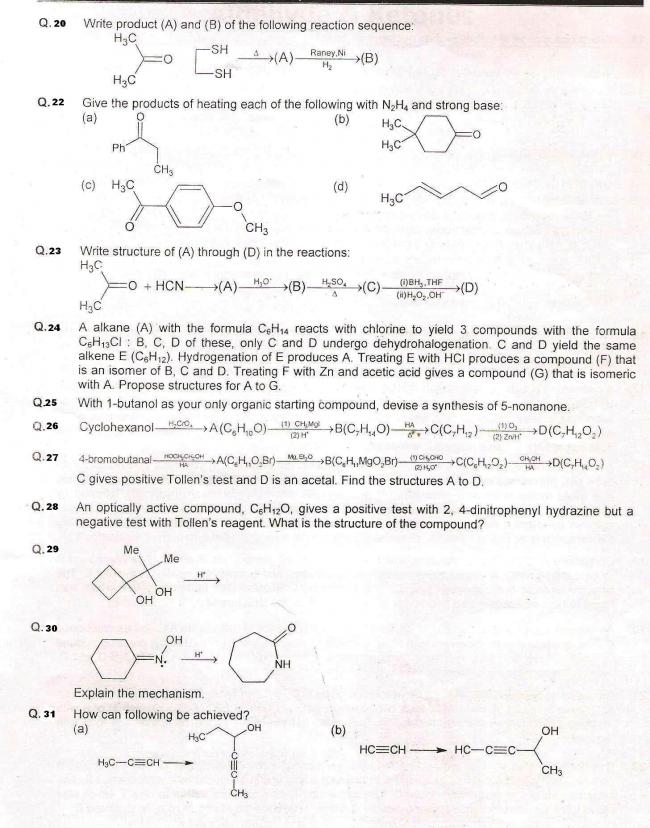
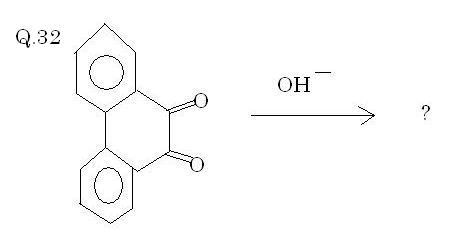
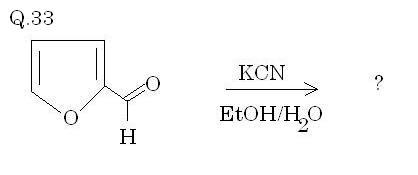

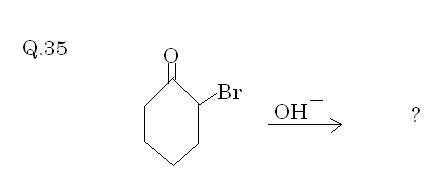
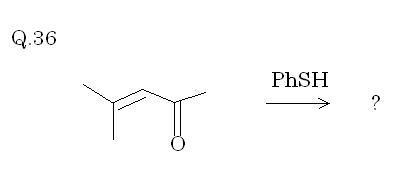
Q37. An organic compound A(C8H16) on ozonolysis yields aldehydes (B) and (C). While (C) performs Cannizzaro reaction, (B) can undergo aldol condensation. B on treatment with excess HCHO in presence of base gives (D) with formula (CnH20O√n). (B) on treatment with red P+HI yields an alkane which contains 1°, 2°, and 4° carbon atoms. Find the structures.
Q38. An organic aliphatic compound (A) when treated with anhydrous ZnCl2 + conc HCl produces a turbidity in 7.5 minutes. (A) decolourises Br2 in CCl4. (A) when treated with ThO2 gives (B). (B) on treatment with 50% H2O2/HIO4 produced three aldehydes - (C), (D), and (E). (C) on treatment with 50% NaOH gave an alcohol of least molecular weight along with sodium salt of an acid (F). (F) is peculiarly capable of reducing Tollen's reagent. (D) on treatment with MeMgBr followed by hydrolysis gives a secondary alcohol of least molecular weight. The formula of (E) is C6H10O2.
(A) on treatment with H2O2/HCOOH produced a compound of molecular formula C9H20O3. (B) on hydrogenation using [RhCl(PPh)3] produces (G). (G) on ozonolysis produces (D) alongside (H). (H) on Clemmensen's reduction produces diethyl dimethyl methane. Identify A to H.
It would be unfair if I did not give some hints here.
1. ThO2 dehydrates alcohols almost exclusively by the Hoffmann route.
2. Hydrogenation by RhCl(PPh)3 or Wilkinson's catalyst exclusively reduces a terminal double bond without affecting internal unsaturations
More to come.
The one who posts the best answers will get a toffee.
Solved Questions/Credit/Hall of Fame :
Q1. Solved by ayush_gupta
Q4. Solved by AnkurG
Q3. Solved by AnkurG
Q8. Solved by AnkurG
Q12. Solved by Manmay (http://targetiit.com/profile/manmay-kumar-mohanty-4967.html)
Q5. Solved by Avik (http://targetiit.com/profile/avik-4025.html)
Q13. Solved by Manmay (" ")
Q15. Solved by Avik (" ")
Q7. Solved by Avik(" ")
Q16. Solved by AnkurG
Q2. Solved by AnkurG
Q30. Solved by AnkurG and perfected by Avik
Q31. Solved by AnkurG
Q29. Solved by AnkurG
Q28. Solved by Avik
Q20. Solved by AnkurG
Q23. Solved by AnkurG
Q24. Solved by Avik
Q17. Solved by Manmay
Q22. Solved by Manmay
Q11. Solved by Manmay(Perfect!!)
Q32. Solved by AnkurG(Bloody brilliant I say)
Q35. Solved by AnkurG(fastest answer)
Q34. Solved by AnkurG(this is getting tedious indeed!)
Q33. Solved by Manmay
Q9. Solved by Avik
Q26. Solved by Avik
Q37. Solved by AnkurG
-
UP 0 DOWN 0 2 87

87 Answers
Q3:
Product 1: HCOOK + (Ph)2CHOH //intra
product 2: SIMILAR product as Product 1 for reactant 2 //intra
product 3:  + side product //inter
+ side product //inter
Q3: all cannizaro's intermolecular and intramolecular species.
Q4: first gilman reagent formation and than alkane formation. Final product: (CH3)2 CH CH2 Ch2 CH3
Excellent ayush. Atleast someone tried. The answer seems perfectly fine to me. Let more replies come.
But do post the image in the right sense...sar ghumaake padhne mein strain padta hai gardan pe lol
And also write the question number...
Q16 --> a) , b), c)
Reason: a) terminal alkynes do give this test, it is the primary test to check presence of terminal alkynes
b) Tollens' test for aldehydes
c) fomic acid shows abnormality with tollens' test coz of extra group of CHO
-> i'M THE FIRST TO GIVE THE REASON
Edit:
as asked Reaction for a:
CH3CH2CH CH + AgNO3 ----(NH4OH) --> CH3CH2CH
CH + AgNO3 ----(NH4OH) --> CH3CH2CH Ag (white precipitate) + NH4NO3 + H2O
Ag (white precipitate) + NH4NO3 + H2O
LOL I never noticed that!! Haha!!
But you are honest. That's good :)
We should request nishant bhaiya to add a hide image feature...because otherwise hiding them is a little absurd.
I just realised tht my Q7's wrong... :(
Tht (A) shud give tollen's but not Iodoform, & i did the vice versa....!!
Edited Answer fr Q7) now :)
lol Avik you're stealing other peoples' joy here :P
I would now request that you all hide your correct answers.
Yes manmay that was nicely done...you're a genius :)
To those who need further explanation for Q13, the premise of the isocyanide test is the detection of foul odour. The isocyanide gas is released only when the boiling point is reasonable. Ionic compounds have quite high boiling points. Isocyanide may form but the odour is not released, hence the test is inconclusive. Salts of acids like COOH and SO3H are ionic. Hence their boiling points are quite high, for lab conditions.
13)
after a long discussion and argument with pritish i finally got the answer as (b) , (c) , (d) thnks to pritish
now we got to make the usual products for a Carbyl amine reaction with given options
after that we will find that
salts of acid are also formed for (b), (c) , (d) and we can conclude that these salts are ionic in nature hence since ionic compunds have a property that they have high boiling point hence the one with high boiling point will not give give Carbyl amine reaction as no isocyanide gas i.e , foul odour can be detected
hence b,c,d since high boiling point they will not give CA reaction
hence final answer : b ,c , d
Made this fr Q10)-

Also, if we have complete hydrolysis we can further hydrolyse to form...
Not guaranteeing 100% accuracy though.. ;)
Ah I see...I didn't understand that before lol. They seem correct to me...unless proved wrong, you're in the HoF again.
@Pritish... Q5) mein 1st two are my products after reaction with 1mole HI (Alcohol& the carbocation one)...phir with excess HI, i have given products separately fr both of them :P
So, the two products after the arrows are my final products.
( i can't think of any more activity in this QN right now :P )
Avik the reason is far from what you are thinking in 13B :P
13) B i am thinking now kyunki in basi Medium it will exist in the carboxylate ion form, so even if the carbene is formed it will go attack the carboxylate group instead of nitrogen.
Phir toh C & D bhi ho sakte hain... :O
Q12)
( A ) is the answer
since we got the reaction as COPE ELIMINATION
and the fact is that Cope elimination is different from E2 in the sense
E2 always goes with anti elimintaion but in case of Cope elimination SYN elimination occurs
so in sense of syn elimination D- is abstracted by O- forming a double bond and N+ too leaves the site
hence final product is (A)
